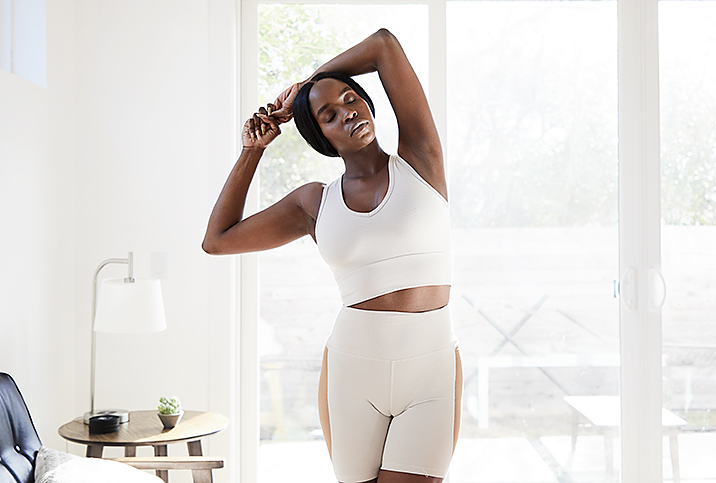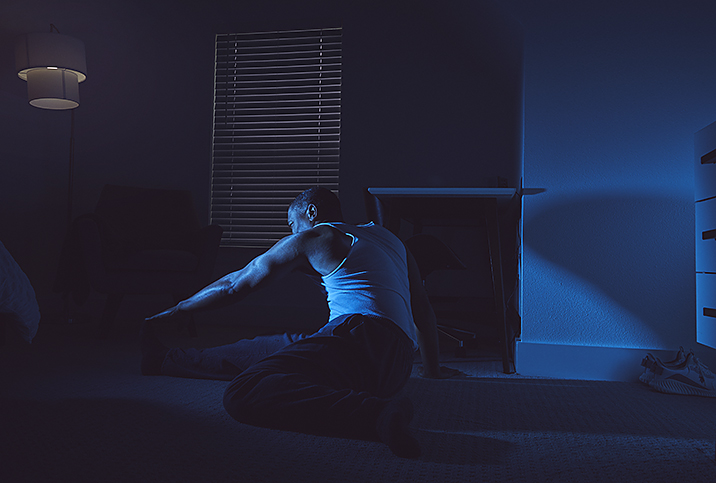The Big Benefits of Exercise

You've heard it a million times: Exercise is good for you and needs to be a part of your regular schedule. But every time you think about starting a new program, you end up thinking, "Ugh, does this really have to be a part of my life…forever?"
Let's be honest: Exercise is hard. It takes effort, it takes motivation, it takes time and energy, and it takes dedication. Stack that up against all the other activities you have to do and want to do in the course of your day, and exercise doesn't always make the list.
No one can blame you for feeling this way. We all feel this way, even folks who exercise on a regular basis. But when you consider the little things in life that can make a big difference in improving overall health and well-being, almost nothing holds a candle to the benefits provided by physical activity.
And if you need additional incentive, keeping fit is crucial for your sexual health. A study published in 2021 in the Journal of Sexual Medicine indicated women who exercised at least six hours per week exhibited less sexual resistance and distress in their clitoral arteries compared to people who did not exercise. Improved blood flow and a healthy circulatory system can improve erectile dysfunction (ED) in men, too.
Exercise can improve your confidence and endurance, lower stress levels, as well as help stave off serious conditions such as diabetes and hypertension.
So, no, a regular, ongoing, lifelong commitment to exercise may not sound exciting. But you know what does sound exciting? The extra years and better quality of life this type of routine can provide.
Exercise really is the "magic pill" so many people are looking for; it just requires a little more work than actually popping a pill.
Why is exercise good for you?
You know exercise uses your muscles and works your heart, and generally makes you sweat and ache. You also know exercise can help you achieve a particular physical "look" and specific physical goals.
But the benefits of exercise reach far beyond the obvious.
Exercise is a lubricant for keeping almost all of your systems functioning at peak capacity. When you exercise, your heart—a muscle—is stimulated to pump blood through your body, delivering key nutrients to your cells while helping buffer waste products out. This helps keep your blood vessels clear from obstruction and encourages cellular turnover while enhancing muscle and bone maintenance and growth. Regular exercise also helps promote good sleep, regulates hormones, bolsters the immune system and enhances your mood.
It can also help improve outcomes in the event of an injury or illness. If you're fit, your body is better prepared to recuperate and repair damage from physical stressors that come its way.
"The benefits of exercise are limitless," explained Kirk Parsley, M.D., a sleep expert and retired Navy SEAL based in California as well as a medical team member for LegacyExpeditions.net Triple 7 Expedition. "When discussing just the major components, such as regulating your cellular energy, regulating fuel partitioning—what your body does with the food you eat—regulating cellular metabolism and cellular energy production, these are adaptations that involve multiple systems and require structural changes on the surface of cells and inside of the cell."
In other words, exercise promotes positive adaptations throughout your body on the cellular level, and every system you have, from your skin and hair to your sexual health, ends up benefiting from these adaptations.
There's one caveat that's important to understand, though.
"Regularity of exercise is the primary component needed to reap the benefits of exercise," Parsley added. "What you do, how much you do, how intensely you exercise are all secondary to consistency. Chaotic or intermittent exercise does not build a strong foundation for these changes. Doing a little bit every day is more effective than doing a lot of exercises sporadically."
Regular exercise is the key
Participating in a regular exercise program has many benefits. Some of the biggest ones include:
- Improved bone strength
- Improved confidence
- Improved management of erectile dysfunction (ED)
- Improved management of sleep apnea
- Improved productivity
- Improved sleep quality
- Improved weight management and body composition
- Increased likelihood of longevity
- Increased stamina for daily life, especially with cardiovascular exercise
- Increased strength (and prevention of muscle loss), especially with resistance training
- Reduced risk of and improved control of prediabetes and diabetes
- Reduced risk of anxiety and depression
- Reduced risk of falls
- Reduced risk of heart disease and heart attack
- Reduced risk of osteoarthritis and improved management of arthritis
- Reduced risk of some cancers
- Reduced risk of stroke
What are the best exercises?
The perfect exercise for you, hands down, is the exercise you'll do consistently. In other words, whatever form of exercise you enjoy, whether that's walking, swimming, playing basketball, lifting weights or going for a bike ride, is the exercise that will work best for you.
As Parsley pointed out, regularity of exercise is more important than anything else. Engaging in any consistent exercise routine reaps more long-term benefits than trying to follow a routine you don't enjoy and don't want to do.
Once you've solidified a consistent, enjoyable routine, you should pay attention to the U.S. government's exercise guidelines for adults to ensure you're hitting all the recommendations.
"Essential exercises of a high-quality exercise routine include strength, mobility and cardiovascular exercise," advised Rosi Reeves, a certified strength and conditioning specialist (CSCS) and personal trainer, and the owner of FittLivin Fitness in Macomb, Michigan.
Cardio
Cardio exercise is any form of exercise that increases the heart rate for an extended period of time. For cardio to be effective at improving heart health, it should be done at a moderate- or high-intensity level.
"Exercise should include what is commonly referred to as 'zone 2' cardiovascular training, which is longer, lower-intensity exercise, like walking, hiking or jogging. This is in the neighborhood of 70 percent of your theoretical maximum heart rate," Parsley explained.
This sounds confusing, but it's actually easy to calculate. To get your theoretical maximum heart rate—it's theoretical because it's an estimate that doesn't account for individual differences—take 220 and subtract your age. Then multiply that number by 0.7 to estimate 70 percent of your maximum heart rate. In other words, if you're 50, the calculation would be:
- 220 - 50 = 170 (theoretical maximum heart rate)
- 170 x 0.7 = 119 (70 percent of your theoretical maximum heart rate)
The Centers for Disease Control and Prevention (CDC) indicates it's OK to exercise a bit lower than that 70 percent mark as well, stating that moderate-intensity exercise is typically between 64 percent and 76 percent of your estimated maximum heart rate. For the above example of a 50-year-old individual, that would range from 109 to 129 beats per minute (BPM). Any exercise done above the 76 percent mark would be considered high-intensity exercise.
High-intensity interval training (HIIT)
It's important to note that HIIT isn't a requirement for staying fit and healthy. In fact, it's not recommended for individuals just starting out with a new exercise program after years of avoiding exercise. But it's a good form of exercise for people who are well-conditioned and looking to reach more sport-specific goals, particularly ones associated with strength, power, speed or body composition.
"The idea is that you are doing exercise that is so intense that it is exhausting your immediate fuel storage for your muscles and conditioning your muscles to be able to create more of this type of immediate fuel for future exercise bouts," Parsley said. "Things like running sprints, hiking as fast as possible up a steep incline, and running up and down stairs or bleachers are all included. It can also be weightlifting routines that focus on maximal repetitions or calories in a finite amount of time. Think of CrossFit or performing supersets."
He emphasized that newbies should wait before jumping into this type of routine.
"I would not incorporate such activities until you have exercised consistently for multiple months and have been cleared by a physician," Parsley said.
Mobility
Mobility work is traditionally thought of as stretching. But these days, stretching doesn't have to fit the mold of the old-school, post-workout, sit-and-touch-your-toes routine. Mobility work can include static or active stretching that moves your body's major joints through their full range of motion. Additionally, it can include yoga, Pilates, foam rolling and guided physical therapy sessions.
Mobility work should be done at least a few times a week; it can be done in conjunction with cardio or strength workouts, or performed on its own.
Strength training
While cardio should be performed most days of the week, strength training doesn't need to be performed as often. The CDC recommends adults perform at least two workouts a week that include strength-building exercises. Reeves said these exercises should target all the major muscle groups, including the upper body, lower body and core, and should include pressing, pulling and pushing exercises in all planes of motion. But you don't have to hit the gym for a traditional weightlifting workout.
"You should be moving some sort of weight other than or in addition to your own body," Parsley said. "You can use things like weights, resistance bands or bodyweight exercises performed with a weight vest or rucksack."
Admittedly, once all the exercise guidelines are laid out, exercise begins to look more like a chore and less like that "Do what you love most" suggestion. But both can be true.
The guidelines provide an outline based on years of exercise science and disease research that indicate these are the types of exercises which should be included each week to maximize your overall health and well-being. However, research is also clear that some exercise is better than none, and consistent exercise garners the best results.
Again, start with what you love (or at least like) and gradually make tweaks to try to hit all the bases.
It's important to note you don't need to do every type of exercise every day. For instance, you can do a 30-minute cardio workout followed by a 10-minute stretch three days a week and perform a 30-minute circuit strength training routine on two other days, which can double as strength and cardio work at the same time. And just like that, you've achieved the recommended five days of exercise for a total of 180 minutes (more than the suggested 150 minutes per week) that hit all the major exercise guidelines.


















